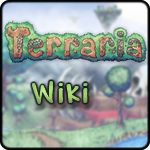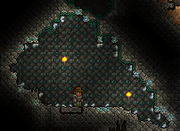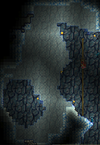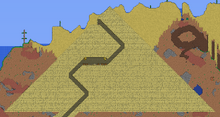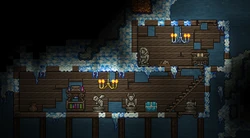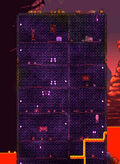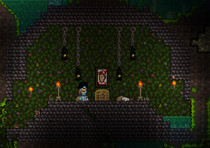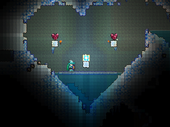Biomes refer to the different types of areas that a Terraria world can contain. Biomes can each contain their own characteristic terrain blocks, collectible items, backdrops, background walls, enemies, critters, theme music, Angler Quest fish, and other traits.
The most common biomes are Forests, located on the surface. Going farther left or right will eventually lead to the Corruption or the Crimson, Deserts, Snow, Jungle, the Dungeon, and at the far right and left of the world, the two Oceans.
"Underground" biomes begin at the Cavern layer and include the Underground Mushroom biome, the Underground Jungle biome, the Underground Snow biome, and the Underground Desert.
The world is also divided into Layers that describe world characteristics depending on depth. The top and bottom layers, Space at the top of the world and The Underworld at the bottom, have biome-like characteristics across the entire map horizontally. Other biomes can also be introduced to these layers (by placing appropriate blocks) to overlap with these depth-based biomes.
After the initial defeat of the Wall of Flesh in The Underworld, the world converts to Hardmode, and new points of Corruption or Crimson will form, as well as a new environment, The Hallow, in addition to underground versions of those.
The Corruption, Crimson, and Hallow are all "contagious" biomes which spread to adjacent blocks. Before Hardmode, the Corruption/Crimson will only spread with their grass, but once Hardmode begins all three biomes will spread directly through most Soil blocks, Vines, and Thorny bushes. All three of these can be removed from small sections of the map with Thrown Powder, and created similarly with Thrown Water. The Clentaminator can add or remove any of these (as well as Mushroom Biome) over much larger areas of the map, using Solutions as ammunition.
Space
Space is a layer appearing at the top of the world: 700 feet and above, for medium worlds. The sky is dark and stars are visible, even when the sun is still up, and low gravity affects players and enemies. Enemies will still spawn in Space, though to a lesser degree. Space has exclusive background and music, and its own distinctive enemies (Harpies from the start of the game and Wyverns during Hardmode).
Surface/Underground
Biomes that appear above the Cavern layer operate as surface biomes, even though they can and do often extend underground. The actual "Underground" versions of biomes, such as the Underground Snow biome, with distinct underground characteristics, do not begin until Cavern layer depths.
Forest
Forests are the most common surface biome, and are where the player usually spawns upon starting a new world. Green Grass grows across the dirt, which can spawn Mushrooms, Daybloom, and Trees. Forests appear whenever no other biome is valid.
Snow
Snow biomes are winter-themed and predominately made of Snow and Ice blocks. They are occasionally home to the player's spawn in a new world. Snow falls constantly, though this is only an aesthetic effect. The Snow biome is always located opposite to the Jungle and thus on the same side of the map as the Dungeon. A minimum of 300 snow or ice blocks are required to create the snow biome.
Desert
Deserts are large expanses of Sand that require at least 1000 sand or other desert themed blocks. They are common between Forests.
Corruption and Crimson
A world will always generate with either Crimson or Corruption, but never both. Each are hazardous biomes that offer access to important loot, crafting materials, and bosses. On ![]() PC,
PC, ![]() Console,
Console, ![]() Mobile,
Mobile, ![]() tModLoader, and
tModLoader, and ![]() tModLoader Legacy, the player is able to choose which biome their world is generated with, provided they have defeated the Wall of Flesh on a separate world, but otherwise it is a 50/50 chance of which one is randomly selected during world generation.
tModLoader Legacy, the player is able to choose which biome their world is generated with, provided they have defeated the Wall of Flesh on a separate world, but otherwise it is a 50/50 chance of which one is randomly selected during world generation.
- The Corruption follows a spooky theme and features vertical chasms, Shadow Orbs, and Demon Altars.
- The Crimson follows a gory theme and features angled passages, Crimson Hearts, and Crimson Altars.
Jungle
The Jungle is a difficult surface biome composed of Jungle Grass, Vines, Mud and Mahogany Trees. The sky appears a vibrant green color. Mahogany Trees respawn automatically without the need to plant Acorns. The Jungle will always be located on the opposite side of the map from the Snow and Dungeon. Very easy to find.
Dungeon
The Dungeon is a difficult labyrinth leading from the Surface down to near-Underworld depths. The Old Man stands at the entrance, and using him to defeat Skeletron will allow you to access to the inside. If you go into the Dungeon before Skeletron is defeated, one or more Dungeon Guardians will spawn and kill you (if you travel below 0 depth). The items/loot found in the Dungeon are rare, valuable, and some cannot be found elsewhere. The Dungeon is always located opposite to the Jungle and thus on the same side of the map as the Snow biome.
Ocean
At each end of every map stands a deep body of water, where dangerous swimming enemies are found, and Water Chests contain ocean-themed loot.
Mushroom
The surface version of the Mushroom biome does not occur naturally, but can be cultivated by players, using Mushroom Grass Seeds or an imported Clentaminator with Dark Blue Solution on surface-level mud. Regardless of the time it will always appear darker than night.
Cavern
The Cavern layer marks the beginning of distinct Underground biome variants, with separate characteristics from their surface versions.
Underground Snow
This is the Cavern layer's portion of the Snow biome. Many ledges and bodies of water will have a layer of thin ice over them, and while these can support the player's weight they can break if you land on them with high enough speed, this can be avoided with Ice Skates or Frostspark Boots. Ice Chests contain ice-themed equipment. It contains more dangerous enemies than its surface counterpart.
Underground Mushroom
This biome features glowing mushrooms on top of mud, and if there is enough height in the cavern, giant mushrooms can grow as well. It has a unique background. it is the only place you can acquire Truffle Worms from.
Underground Jungle
The Underground Jungle is a difficult biome found at Cavern depth under the surface Jungle. Its dense catacomb of compartments contain several hazards and dense vegetation, as well as important loot and crafting materials. In Hardmode, valuable Chlorophyte Ore can be mined here. There are three bosses in this biome. In here lies the Bee Hive, where the Queen Bee boss is located. After the Mechanical Bosses have been defeated, Plantera's Bulbs spawn, allowing the player to summon Plantera, an important boss. The Jungle Temple is also found here, where the Golem boss can be summoned after Plantera is defeated.
Underground Desert
The Underground Desert is a difficult pre-hardmode biome found at the Cavern layer under the surface Desert. The biome is always sphere-shaped and contains various types of Antlions as well as ancient-Egyptian themed enemies in Hardmode.
Underworld
The Underworld is a difficult area located along the entire bottom of the world. Lava pools cover much of its terrain and dangerous enemies spawn often. Hellstone can be mined here, Ruined Houses offer valuable loot (some within their Shadow Chests), and unique furniture, and the Wall of Flesh boss can be summoned here in order to activate Hardmode. In hardmode, you can find the Tortured Soul here, which you can convert to the Tax Collector NPC using Purification Powder.
Hardmode
Hardmode biomes spawn or convert as a result of the game transitioning to Hardmode.
The Hallow
The Hallow is the "anti-corruption" biome, which is automatically created once the player activates Hardmode by defeating the Wall of Flesh. The biome has pastel-colored imagery but is nevertheless highly difficult.
Underground Hallow
The Underground Hallow is located beneath surface Hallow, starting at the Cavern layer. It has a different soundtrack from the overworld Hallow, and contains even more difficult enemies as well as valuable items, like Soul of Light and Crystal Shard.
Underground Corruption
The Underground Corruption is created in the Cavern layer upon defeating the Wall of Flesh. It shares the same feel as the overworld Corruption, but has different enemies, a different soundtrack (a mix of the regular Underground and Corruption soundtrack), and it's the only place to find Souls of Night and Cursed Flames. All enemies from the overworld version are present, as well as World Feeders, Clingers, and Cursed Hammers.
Underground Crimson
The alternative to the Underground Corruption, which functions and is spawned in mostly the same way. The Underground Crimson, like the Corruption variety, will have enemies occasionally drop Souls of Night. This is the only place where enemies drop Ichor.
Corrupted/Crimson Deserts & Hallowed Deserts
When the world enters Hardmode, several Deserts of the world will become either corrupted, crimsoned, or hallowed. These have their own backgrounds, and spawn unique versions of the Mummy with unique drops. Sand is replaced by Ebonsand, Crimsand, or Pearlsand. It is possible for a world to be generated with a Corrupt or Crimson Desert.
Mini Biomes
Biomes in this category tend to be small in number and size. They have unique characteristics and monster spawns.
Meteorite
Whenever a Shadow Orb or a Crimson Heart is destroyed, there is a chance that within the next day the game will spawn a meteor and display the message "A meteorite has landed!". The meteor will crash into land and turn a large portion of the surrounding tiles into Meteorite. Meteorite will defect the player with the Burning debuff if they do not have an accessory that nullifies fire's effects, and/or an Obsidian Skin Potion. Meteorite requires a Tungsten Pickaxe, Gold Pickaxe, or better, in order to mine the meteorite. Meteor Heads and Lava Bats are the only enemies that spawn instead of the other natives.
Spider Nest
Spider Nests are rare mini-biomes that can be located underground, noted by the black background wall and the numerous webs filling the area. This biome will spawn Wall Creepers before Hardmode and Black Recluses during Hardmode. The Cobwebs filling this area rapidly grow back, which is a unique feature of the biome. Spider Nests are the only location where one can find Web Covered Chests and all unique treasures discovered therein. The Stylist NPC is found in this biome.
Bee Hive
The Bee Hive occurs in the Underground Jungle. Bee Hives are made from Hive blocks and contain Honey and often a Larva. If you destroy the larva, it will summon the Queen Bee boss. When you break a Hive block, a bee and/or honey may come out. There can occasionally be two or three hives next to each other.
Jungle Temple
A large, near impenetrable, structure that spawns deep in the Underground Jungle. It is filled with powerful enemies and is only accessible after defeating Plantera and using a Temple Key to open the door. In the largest chamber, you can spawn Golem.
Marble Caves
An Underground cave area that is horizontal in shape and made completely out of Marble. It is generally themed around Ancient Greece. Marble Caves contain enemies such as Hoplites and Medusa.
Granite Caves
An Underground cave area made completely of Granite, usually quite spacious with interspersed ledges and platforms. Granite Caves contain enemies such as Granite Elementals and Granite Golems.
Micro Biomes
Gemstone Cave
A Gemstone Cave is filled with concentrated gem deposits of one or more varieties and features a unique background (a gemstone wall) that is speckled with gems of the same color found in the Gemstone Cave.
Moss Chamber
A micro biome found in the Underground and Cavern layers that contains one color of Moss with a matching back wall.
Campsite
A micro biome found in the Underground and Cavern layers usually containing a Campfire, Silver Coin Pile, and a background object of skeletal remains. The campsite is 12 - 20 blocks wide, and not quite as tall.
Thin Ice Patch
A micro biome found in the Underground Snow Biome that is made entirely of Thin Ice and the occasional ore vein.
Treasure Rooms
Treasure rooms are spawned with world creation and appear as if they were man-made structures. They generally contain loot and furniture.
Floating Islands
Floating Islands are independent masses of land in the sky. Once located, and when the player obtains the tools to reach them, they have access to their unique furniture and some powerful loot. Harpies (Arch Wyvern and Wyvern in Hardmode) attack at their height.
Living Tree
Living Trees are huge, thick trees that can be generated. Cutting the tree yields regular Wood. Some of those trees can be hollow and lead deep underground. There may be rooms containing Living Wood Chests with related loot inside, as well as Living Wood Doors, Living Wood Chairs, Living Wood Tables, Living Loom and other Living Wood furniture. It is not guaranteed that one will spawn in every world.
Pyramid
Pyramids are sometimes generated in the Desert at world creation. They are made of Sandstone Brick and contain a narrow passage. The treasure room is filled with coins, vases and a gold chest that can contain unique loot, also in the mobile version there is usually another secret room containing more vases, money, and chest. There is also a passage to a cave at the bottom. It is not guaranteed that one will spawn in every world.
Underground Cabin
Underground cabins are typically wooden buildings full of dusty, broken furniture as well as chests, vases, and occasionally usable furniture and decorations. They are found in the underground in the cavern, glowing mushroom, jungle, desert, and snow biomes. As of 1.3.0.1, underground cabins now spawn with wood and walls that are unique to their biome.
Jungle Shrine
Jungle Shrines are small brick buildings and typically contain only a single chest and a light source. They are found in the Underground Jungle and several can appear in one biome.
Enchanted Sword Shrine
Houses an Enchanted Sword, an Arkhalis or a fake sword. Every shrine will contain one breakable background sword sprite, which has a 2/3 chance of being a fake sword and a 1/3 chance of being a real sword, which has a 1/10 chance of dropping the Arkhalis, instead of the Enchanted Sword, when destroyed.
Ruined House
Ruined houses are generated at World creation in The Underworld in the middle 50% of the Underworld. They are towers with multiple levels, constructed with missing parts for a "ruined" look, from Obsidian Brick or Hellstone Brick. They are sometimes partially submerged in lava and often contain deposits of hellstone just outside their walls.
Jungle Sanctum
A Jungle Sanctum is a Windows Phone version exclusive structure that occasionally appears in Jungles. Jungle Sanctums are a larger version of Jungle Shrines and contain Coin Stashes, along with an Ivy Chest that contains several jungle-themed items.
Heart Shrine
Exclusive to the Windows Phone version, Heart Shrines are heart-shaped caves sometimes found in Snow biomes. They hold two Crystal Hearts and a chest that may contain "heart"-items. They can contain Heart Lanterns, Heart Statues, Heart Potions, among other items.
Hybrid Biomes
While many of the basic biomes appear at world generation or triggered by events, it is possible for hybridized biomes to be synthesized by player action or, in Hardmode, by world mechanics.
Hybrid Biomes
Hybrid biomes are those created by the requirements being met for multiple biomes in a certain space. The simplest examples are Hallowed, Crimson, or Corrupt Deserts; however, not only Deserts can be hybridized. Floating Islands can be Corrupted/Crimsoned or Hallowed upon entry of Hardmode, and such high-layered biomes are even required by some Angler quests. Player action can similarly introduce Corruption, Crimson, Hallow, Desert, Jungle, Mushroom, Meteorite, or Snow biomes to any location from Underworld to Sky and likely even Space. This can lead to, for example in an Underworld Crimson, Underworld and Crimson enemies both spawning in the applicable areas.
Biome Existence Requirements
The area used for counting required blocks for the existence of biomes at a location, appears to be 50 tiles to each side and approximately 42 below and 44 above. Note that Compatible Biomes lists the biomes which can co-exist in the same general location, and has nothing to do with spreading mechanics.
| Name | Block Requirements | Location | Compatible Biomes |
|---|---|---|---|
| Forest | N/A | Above the Underworld | Sky, Surface, Underground, Cavern, Ocean |
| Corruption | At least 200 |
Any | Not Forest, Meteorite, or Hallow |
| Crimson | At least 200 |
Any | Not Forest, Meteorite, or Hallow |
| Mushroom | At least 100 |
Any | Not Forest or Meteorite |
| Jungle | At least 80 |
Any | Not Forest or Meteorite |
| Hallow | At least 100 |
Any | Not Forest, Meteorite, Corruption, or Crimson |
| Desert | At least 1,000 |
Any | Not Forest or Meteorite |
| Corrupt Desert |
At least 1,000 |
Any | Not Forest, Meteorite, or Hallow |
| Crimson Desert |
At least 1,000 |
Any | Not Forest, Meteorite, or Hallow |
| Hallow Desert |
At least 1,000 |
Any | Not Forest, Meteorite, Corruption, or Crimson |
| Ocean | At least 1,000 block spaces of |
Outer lateral edges of the world, above Cavern layer | Not Meteorite, Corrupt Desert, Crimson Desert, or Hallowed Desert |
| Snow | At least 300 |
Any | Not Meteorite or Desert |
| Meteorite | At least 50 |
Any | None |
| Dungeon | At least 250 |
Below -4 feet | None |
- ↑ Note that the requirement for naturally-placed Walls makes a synthetic Dungeon biome nearly impossible and, if accomplished, it would be unable to spawn Hardmode Dungeon enemies or Cursed Skulls (as they require naturally-placed Dungeon Brick Walls), though it may be useful for creating a lake for farming Dungeon Crates. It appears that the only option for expanding the space in which Hardmode Dungeon enemies can spawn is by mining blocks already inside the area in which the Dungeon originally generated, without damaging any naturally-placed Walls they are covering.
Notes
- For Hallowed and Crimson/Corruption biome detection: There is a Hallowed value, a Crimson value, and a Corruption value. Each Hallowed block adds 1 to the Hallowed value and subtracts 1 from both the Crimson and Corruption values. Each Crimson block adds 1 to the Crimson value and subtracts 1 from the Hallowed value. Each Corruption block adds 1 to the Corruption value and subtracts 1 from the Hallowed value. This can be proven by placing 100 Hallowed blocks in an otherwise completely neutral area, observing that the area will change to Hallowed on placement of the 100th block, then that it will return to neutral on placement of a Crimson or Corruption block, then back to Hallowed on placement of an additional Hallowed block, ad infinitum.
- For Snow biome detection: the background of a snow biome will not appear until 301 Snow biome blocks are present (not at 300, where the biome changes functionally).
- For Dungeon biome detection: the game checks the number of Dungeon blocks (=>250), and checks only the single background wall the player is standing in front of. This wall must be naturally placed, from the original world creation.
- Inactive blocks (Actuated blocks) will count towards the formation of a biome.
